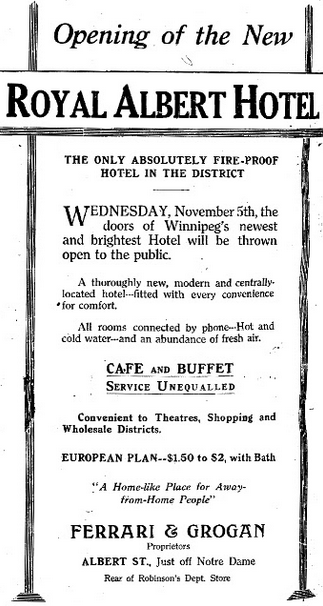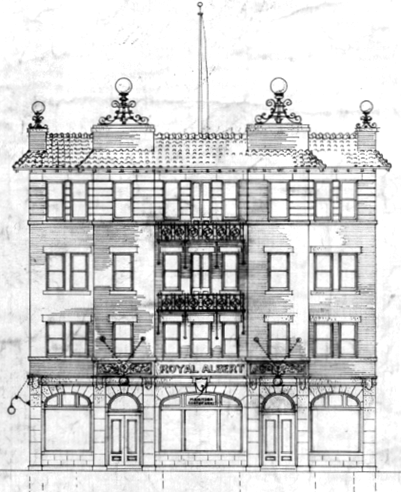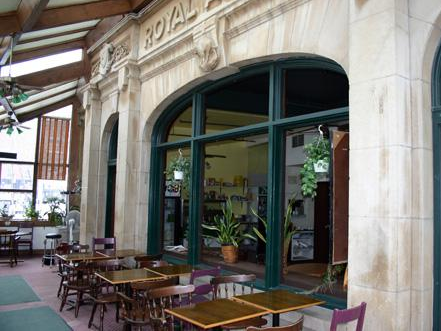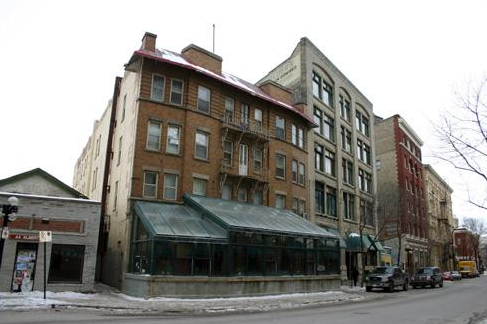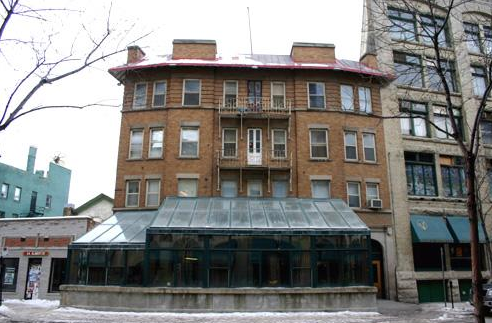Buildings
Royal Albert Arms Hotel
| Formerly: | Royal Albert Arms Hotel |
|---|---|
| Address: | 48 Albert Street |
| Constructed: | 1913 |
| Architects: | E.D. McGuire |
| Tours: | Part of the QR Code Tour |
More Information
The four-storey Royal Albert Arms Hotel, a brick, steel and concrete structure erected in 1913 and expanded at the front by a modern glassed-in cafe, stands mid-block among a number of its commercial contemporaries on a narrow winding street in Winnipeg's Exchange District, a national historic site. The City of Winnipeg designation applies to the building on its footprint.
Heritage Value
The Royal Albert Arms Hotel is a fine example of the many small hostelries built to serve business and pleasure travellers during Winnipeg's 1900-14 boom. Its design by E.D. McGuire features an impressive Spanish Colonial Revival-style front of brick and stone that opens on to a modestly appointed interior. Strategically situated between the Main Street-Portage Avenue business districts and rows of warehouses to the west and north, the facility retains its original function and also supports the historic continuity of its streetscape, which is occupied by several other designated hotels and commercial buildings.
Source: City of Winnipeg Committee on Environment Minutes, May 19, 1981
For more information:
Design Characteristics
- Key elements that define the heritage character of the Royal Albert Arms Hotel site include:
- - its location on the west side of Albert Street between Notre Dame and McDermot avenues
- - the building's placement, facing east, its front slightly curved to accommodate a jog in the street
- - the building's proximity to other commercial structures of similar scale, materials, design and/or age
- Key elements that define the hotel's exterior character and Spanish Colonial Revival style include:
- - the L-shaped form, four storeys high, wide at the front, with a long rear volume and a one-storey subsidiary section on the north side
- - the flat roof with a Spanish-style front overhang pierced by brick extensions of the corners and two interior bays and with side and rear brick parapet walls
- - the impressive front, symmetrically composed and amply lit, including the main floor's ashlar stone cladding and arched window and door openings, and the upper levels, finished in light brown brick and divided into five bays by the placement of lintelled windows, two slight pavilions and a distinctive centre section containing openings grouped in threes and wrought-iron balconies with large brackets on the third and fourth floors
- - the plain side and rear elevations with rows of flat-headed sash windows in singles and pairs; also with transomed rear fire escape doors on the upper three floors, a rear loading door, etc.
- - the fine stone detailing, including architraval-framed entrances with delicately carved ornamentation, a Manitoba coat of arms keystone and the name 'ROYAL ALBERT' in raised letters above the arched centre window, etc.
- - other materials and details such as the concrete lintels, sills and front stringcourses, the rusticated front fourth-floor brickwork, the tall brick chimney, flagpole, etc.
- Key internal elements that define the hotel's layout and function include:
- - the deep main-floor plan with a high beamed ceiling and dark-stained woodwork, including a central lobby with wainscotting and upper glassed walls exposing a kitchen, a cafe with panelling and a rear bar
- - the utilitarian layout of the upper floors based on a central staircase and long hallways with rooms to both sides and with communal washrooms
- - other features and materials such as the main-floor's pressed tin ceilings and elegant arched or vaulted skylight of stained glass surrounded by delicate mouldings, etc.
